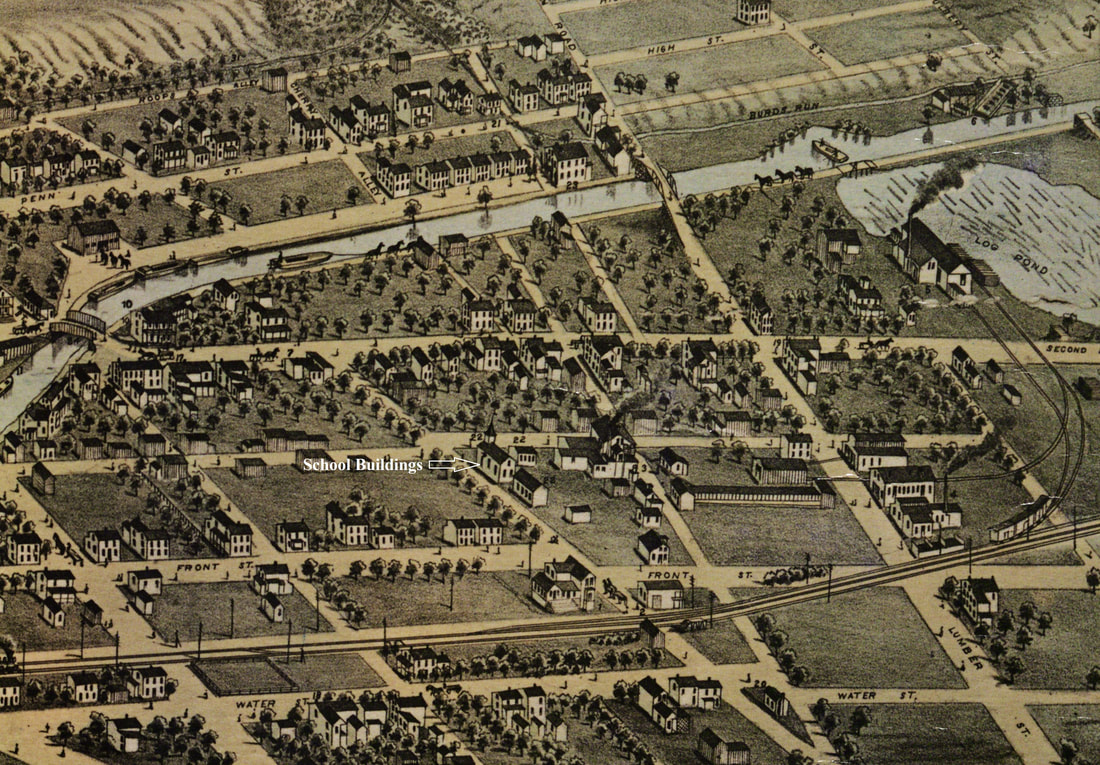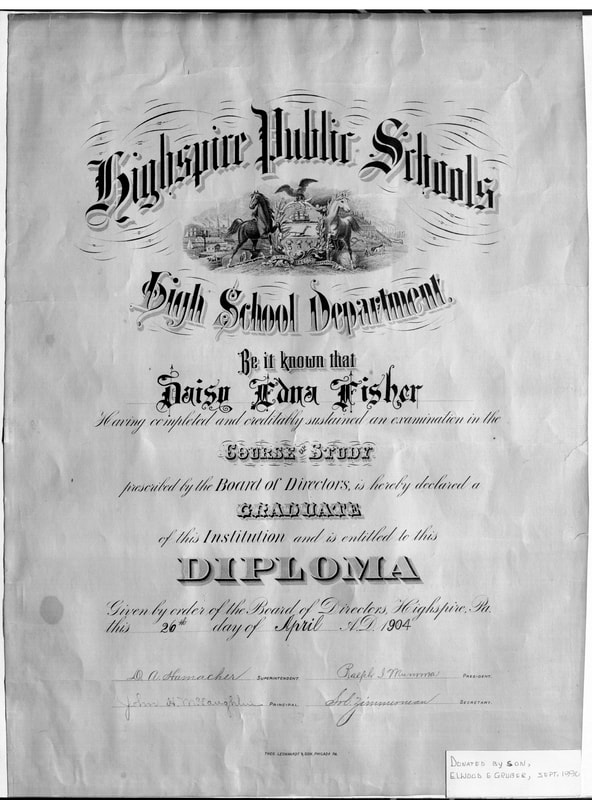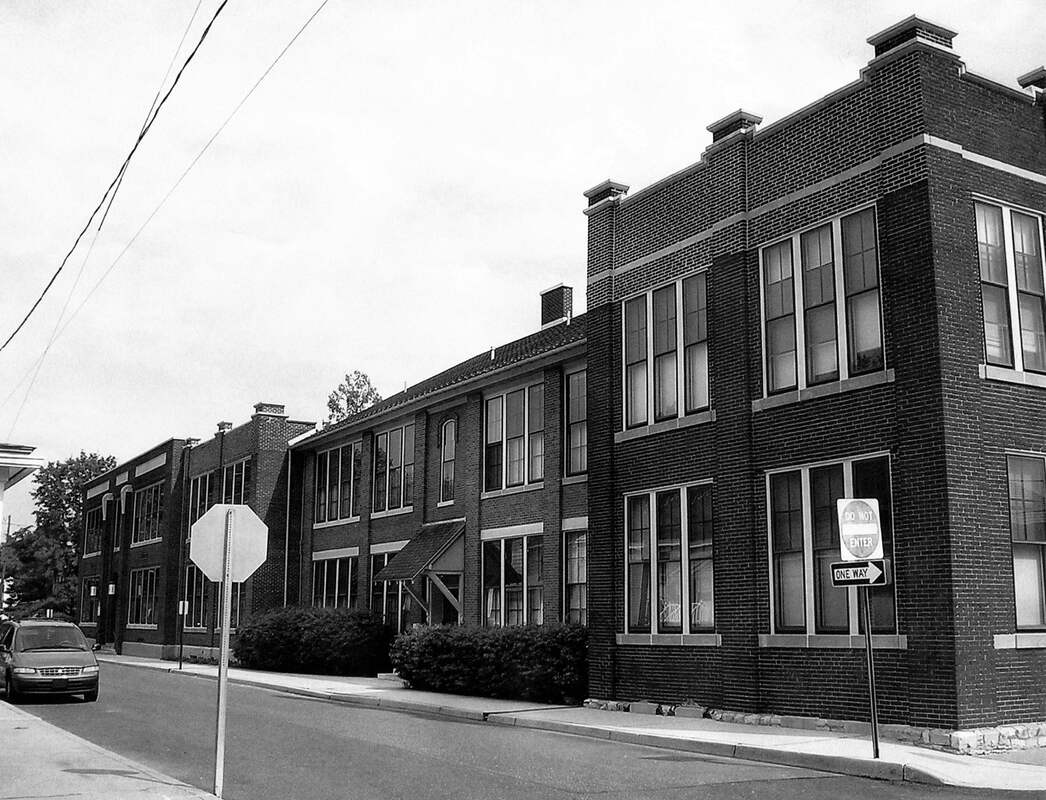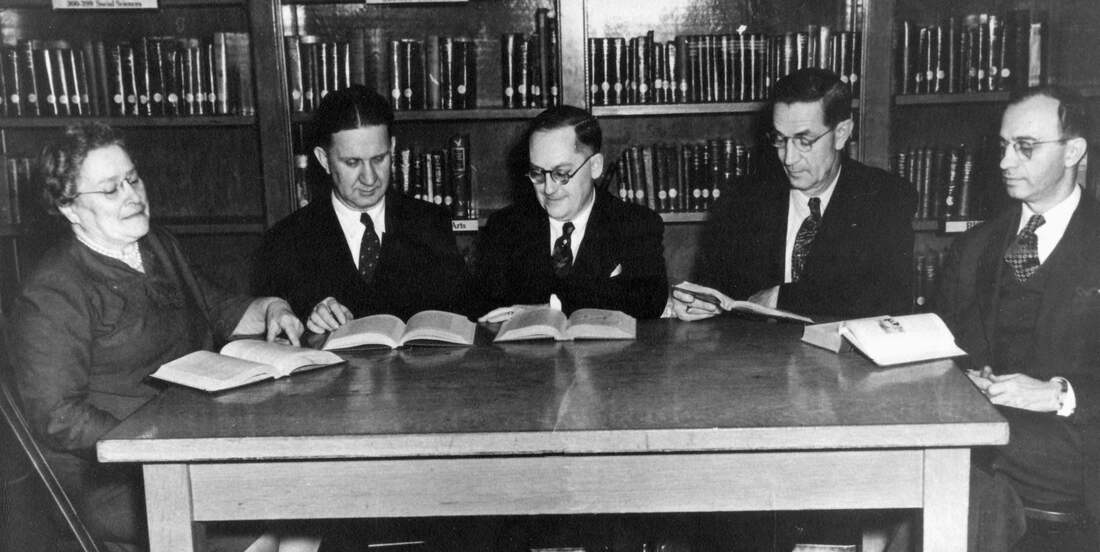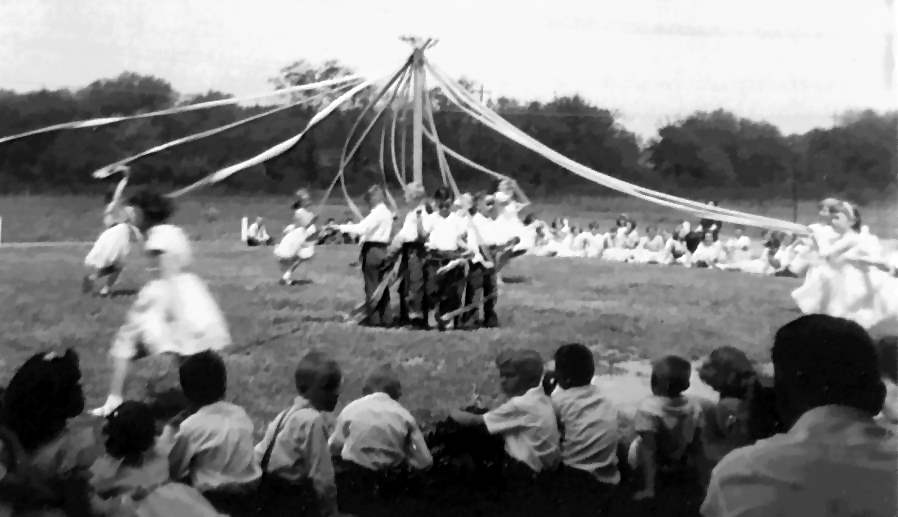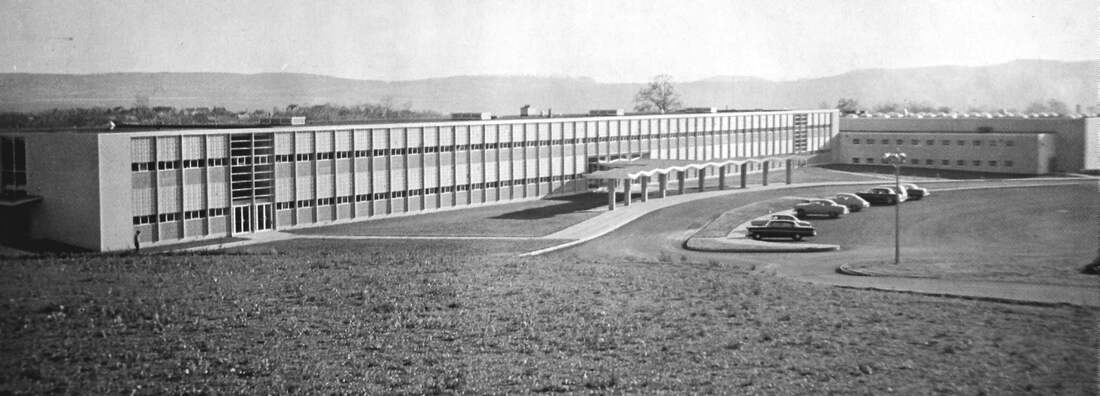Schools
In his 1907 “History of Dauphin County,” Luther Reily Kelker reported that free schools were not
adopted in Lower Swatara Township until 1843. The local farmers generally were opposed to free
schools, but the citizens of Portsmouth (now part of Middletown) organized to get out the town vote
and took advantage of bad weather on Election Day to approve a free public school system and elect
directors who were in favor of establishing schools.
adopted in Lower Swatara Township until 1843. The local farmers generally were opposed to free
schools, but the citizens of Portsmouth (now part of Middletown) organized to get out the town vote
and took advantage of bad weather on Election Day to approve a free public school system and elect
directors who were in favor of establishing schools.
The first school in Highspire was a complex of two buildings on the southeast corner of Railroad Street and Lusk Avenue, just west of the Wilson Distillery. That area would become part of the distillery complex by the late 1800s.
The first Highspire School was located on the southeast corner of Railroad Street and Lusk Avenue.
Kelker writes: “In 1875 a fine, large building was erected by the (Lower Swatara Township) board consisting then of George W. Parthemore, A. Ebersole, J. Bingaman, J. Yingst, Isaac Mumma, and J.J. Lehman.” That was the original school building at the corner of Roop and Penn Streets.
This picture of the original school building at Roop and Penn streets was taken before the Roop
Street extension in 1915. The cupola on the front roof contains a school bell. You can tell that the building is set back from Roop Street by comparing it to the Chubb’s Market building, to its right.
Street extension in 1915. The cupola on the front roof contains a school bell. You can tell that the building is set back from Roop Street by comparing it to the Chubb’s Market building, to its right.
When Highspire incorporated in late 1903, it established its own school system. D.A. Hamacher was the first superintendent, John H. McLaughlin principal, Ralph Mumma school board president, and Sol. Zimmerman secretary. The school was established with a three-year high school. Students wanting to go on to college often went to Steelton to complete their fourth year. In 1926, the fourth year was added to Highspire’s high school. About half the graduating Class of 1925 came back for their fourth year in 1926 and graduated again.
Daisy Fisher (Daisy Gruber) was in the first graduating class of
Highspire High School, in 1904.
Highspire High School, in 1904.
In 1902 an addition was built on the east side of the original building which doubled the size of the building and made it symetrical around a new entrance on Penn Street. The original school at the corner of Roop and Penn Streets had a very wide sidewalk on the Roop Street side. In 1915, an addition, about 30 feet by 75 feet, was built on the Roop Street end of the school. In 1926 an extension was completed on the east side of the building to provide a combination auditorium and gymnasium. That space would be used as a shop in the 1940s and 1950s, and then as a cafeteria after 1961. The last building expansion was completed in 1939. It added a much larger auditorium-gymnasium with permanent seating, and four classrooms, including a home economics room. In the spring of 1941, the playground behind the school along Broad Street was paved with macadam.
This is a picture of the Highspire School Apartments. From the Penn Street side, the building looks as it did when it was the Highspire School, which was built in five parts between 1875 and 1939. The addition on the right end, in the foreground, was built in 1915. The section to its immediate left is the original 1875 building. The section immediately to the left of the covered entrace was built in 1902. The next section was completed in 1926; it matched the 1915 extension and made the building symmetrical on the Penn Street side. The last expansion, completed in 1939, is on the far left.
This was the Highspire School Board from 1944 to 1950. Shown in the school library seated left
to right are Bessie Poorman, secretary; William White, treasurer; Paul Zeller; Roy Knight; and
Dr. William J. Albright, president. (Photo courtesy of Jane Albright Solomon)
to right are Bessie Poorman, secretary; William White, treasurer; Paul Zeller; Roy Knight; and
Dr. William J. Albright, president. (Photo courtesy of Jane Albright Solomon)
In 1927, a three-room elementary school was built on the eastern end of Eshleman Street. That building would be used intermittently until the early 1960s, with elementary grades varying according to need. During World War II, it served as administrative offices for a temporary housing complex to house Olmstead Air Force Base employees. In 1961, the Highspire East Building was closed. For a few years after that it was used by the private Christian Day School. Between 1964 and 1968, Highspire Borough occupied the building, and it now houses the borough offices and police headquarters. See the photo on the Borough page.
This picture is of a May Day celebration at the East End elementary school in 1957.
(Photo courtesy of Dean Stefan)
(Photo courtesy of Dean Stefan)
The Highspire School District existed as an independent district for 50 years. On April 13, 1954, a jointure with Steelton was formed creating the Steelton-Highspire School District. In June 1955, Lowrie & Green Architects was employed to design a high school on a 42-acre site at the top of Swatara Street in Swatara Township that the Steelton School District had purchased for $20,000 in 1948. On May 28, 1957, ground was broken for a 128,002-square-foot building with a capacity for 1,296 students, with a 750-seat auditorium, 400-seat cafeteria, and 2,400-seat gymnasium. The total project cost with building construction and equipment was $2,428,848. The first day of school in the new building was Sept. 3, 1958.
The Steelton-Highspire High School opened in fall 1958. The Class of 1959 was the first to graduate
from the school.
from the school.
Dr. Harold T. Griffith was appointed superintendent of the new joint school district, and LaRue C. Derr, previously supervising principal of the Highspire School, was appointed assistant superintendent and principal of the Highspire Elementary School.
Starting in the 1955-56 school year, Highspire junior and senior high school students had the option of taking classes at Steelton. Starting in the 1956-57 school year, all Highspire students starting junior high (seventh grade) were bused to the Felton Building at Steelton; and in the 1957-58 school year, all school extracurricular activities were combined. Finally, in 1958 the new Steelton-Highspire High School opened for grades seven through twelve. The Class of 1959 was the first to graduate from the new high school. The Class of 1964 was the first class to take all their junior and senior high school classes in the new building.
After the new junior and senior high school opened, the Highspire schools became local elementary schools. In 1961, the Highspire East Building was closed and a kindergarten and cafeteria were established at the main building. That building would continue to be used as an elementary school until 1983, when all Steelton-Highspire elementary classes were combined in the Felton Building in Steelton. In November 2007, a new Steelton-Highspire Elementary School opened near the high school.
Starting in the 1955-56 school year, Highspire junior and senior high school students had the option of taking classes at Steelton. Starting in the 1956-57 school year, all Highspire students starting junior high (seventh grade) were bused to the Felton Building at Steelton; and in the 1957-58 school year, all school extracurricular activities were combined. Finally, in 1958 the new Steelton-Highspire High School opened for grades seven through twelve. The Class of 1959 was the first to graduate from the new high school. The Class of 1964 was the first class to take all their junior and senior high school classes in the new building.
After the new junior and senior high school opened, the Highspire schools became local elementary schools. In 1961, the Highspire East Building was closed and a kindergarten and cafeteria were established at the main building. That building would continue to be used as an elementary school until 1983, when all Steelton-Highspire elementary classes were combined in the Felton Building in Steelton. In November 2007, a new Steelton-Highspire Elementary School opened near the high school.
Children on the steps of the east Penn Street entrance to the Highspire Elementary School in
the 1970s. (Photo courtesy of Harry H. & Helen E. Gross Family)
the 1970s. (Photo courtesy of Harry H. & Helen E. Gross Family)
Today, the Highspire school building has been converted to an apartment building for senior citizens 55 and older. The owner, Housing Development Corp. MidAtlantic, has kept the exterior of the building the same as it was when it was a school. Inside, some reminders of the old school such as lockers and wainscoting were retained. The Steelton-Highspire School District has now been in place longer than the independent Highspire School District, as long as the Lower Swatara Township schools in Highspire.
Public Library
Although Highspire never had its own public library, its residents had local access to library resources for many years. Dating back at least to the early 1900s, the Dauphin County Extension of the Harrisburg Public Library operated circulation stations in private homes.
In 1932, the circulation station was located in Shoemaker’s Drug Store under the management of Claudia Shoemaker. In 1950, by arrangement with the school board, the public lending library was co-located with the school library under librarian Helen Gross. The library was open to the public one afternoon and evening each week.
After the jointure of the Steelton and Highspire School Districts, the arrangement between the Dauphin County Extension and the school district continued, with Mrs. Gross being the librarian for the Steelton-Highspire elementary schools. In 1964, circulation to the public averaged 60 books per week.
Local public library access ended when the Highspire elementary school closed in 1983.
In 1932, the circulation station was located in Shoemaker’s Drug Store under the management of Claudia Shoemaker. In 1950, by arrangement with the school board, the public lending library was co-located with the school library under librarian Helen Gross. The library was open to the public one afternoon and evening each week.
After the jointure of the Steelton and Highspire School Districts, the arrangement between the Dauphin County Extension and the school district continued, with Mrs. Gross being the librarian for the Steelton-Highspire elementary schools. In 1964, circulation to the public averaged 60 books per week.
Local public library access ended when the Highspire elementary school closed in 1983.
